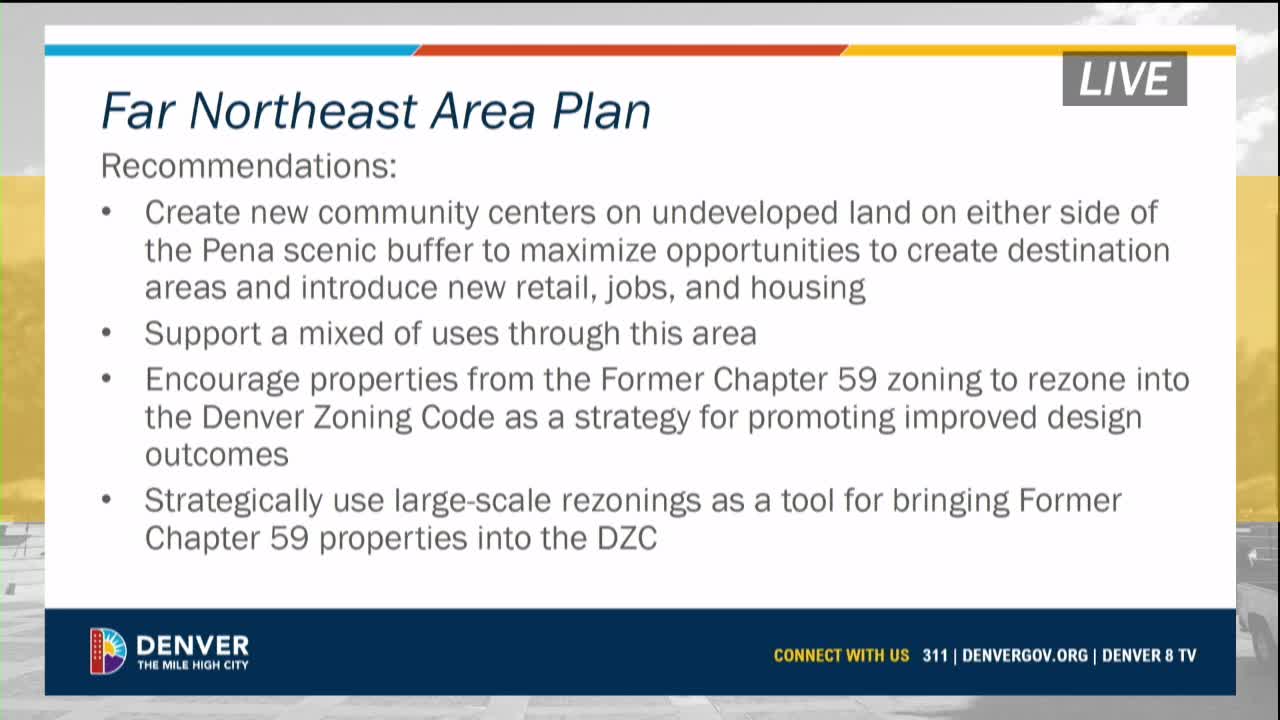Denver City Council considers major rezoning to boost affordable housing development
January 07, 2025 | Denver (Consolidated County and City), Colorado
This article was created by AI summarizing key points discussed. AI makes mistakes, so for full details and context, please refer to the video of the full meeting. Please report any errors so we can fix them. Report an error »

In the heart of Denver's city hall, a pivotal discussion unfolded as the Land Use, Transportation & Infrastructure Committee convened to address a significant rezoning proposal. The atmosphere was charged with anticipation as committee members and city planners gathered to deliberate on a large-scale rezoning initiative that promises to reshape a substantial parcel of land.
The proposal, presented by Tony Lechuga from the City Planning Department, aims to transition a 12-acre site from its outdated Planned Unit Development (PUD) zoning to a more flexible zoning code. This change is designed to enhance public health, safety, and welfare by aligning with Denver's current zoning standards and allowing for a greater mix of residential and commercial uses. The committee's discussions highlighted the urgent need for more housing options in the city, particularly as Denver grapples with a housing crisis.
Councilmember Cashman raised a critical question regarding the previously mandated cap of 291 residential units for the superblock, expressing concern over its limitations. The committee acknowledged that the city's recent planning documents advocate for a more diverse range of uses without strict maximums, reflecting a shift in approach to density and development.
As the conversation progressed, the committee explored the implications of the rezoning on transportation and infrastructure. Councilmember Hines inquired about the proximity of the site to the RT light rail line and the absence of a nearby stop, prompting discussions about future transit-oriented development (TOD) aspirations. Although the site lies outside typical TOD boundaries, planners emphasized the importance of connecting regional trails to enhance accessibility.
The impetus for the rezoning emerged from community conversations, particularly with Councilwoman Gilmore, who advocated for more attainable housing options. Tyler Carlson from Evergreen Development shared insights into the collaborative efforts with local builders to create for-sale attached housing, responding to the community's desire for diverse housing types.
Concerns about transportation infrastructure were also raised, particularly regarding the potential impact on Pena Boulevard as density increases. Committee members expressed the need for ongoing dialogue with transportation agencies to ensure that infrastructure keeps pace with development.
As the meeting drew to a close, the committee expressed optimism about the proposal's potential to meet the city's housing needs while fostering community engagement and collaboration. With plans to execute a development agreement that aligns open space requirements with residential standards, the committee is poised to advance the proposal to the full council for a vote.
This meeting marks a significant step in Denver's ongoing efforts to adapt its land use policies to better serve its residents, reflecting a commitment to creating a more inclusive and accessible urban environment. As the city continues to evolve, the outcomes of this rezoning initiative will undoubtedly play a crucial role in shaping Denver's future landscape.
The proposal, presented by Tony Lechuga from the City Planning Department, aims to transition a 12-acre site from its outdated Planned Unit Development (PUD) zoning to a more flexible zoning code. This change is designed to enhance public health, safety, and welfare by aligning with Denver's current zoning standards and allowing for a greater mix of residential and commercial uses. The committee's discussions highlighted the urgent need for more housing options in the city, particularly as Denver grapples with a housing crisis.
Councilmember Cashman raised a critical question regarding the previously mandated cap of 291 residential units for the superblock, expressing concern over its limitations. The committee acknowledged that the city's recent planning documents advocate for a more diverse range of uses without strict maximums, reflecting a shift in approach to density and development.
As the conversation progressed, the committee explored the implications of the rezoning on transportation and infrastructure. Councilmember Hines inquired about the proximity of the site to the RT light rail line and the absence of a nearby stop, prompting discussions about future transit-oriented development (TOD) aspirations. Although the site lies outside typical TOD boundaries, planners emphasized the importance of connecting regional trails to enhance accessibility.
The impetus for the rezoning emerged from community conversations, particularly with Councilwoman Gilmore, who advocated for more attainable housing options. Tyler Carlson from Evergreen Development shared insights into the collaborative efforts with local builders to create for-sale attached housing, responding to the community's desire for diverse housing types.
Concerns about transportation infrastructure were also raised, particularly regarding the potential impact on Pena Boulevard as density increases. Committee members expressed the need for ongoing dialogue with transportation agencies to ensure that infrastructure keeps pace with development.
As the meeting drew to a close, the committee expressed optimism about the proposal's potential to meet the city's housing needs while fostering community engagement and collaboration. With plans to execute a development agreement that aligns open space requirements with residential standards, the committee is poised to advance the proposal to the full council for a vote.
This meeting marks a significant step in Denver's ongoing efforts to adapt its land use policies to better serve its residents, reflecting a commitment to creating a more inclusive and accessible urban environment. As the city continues to evolve, the outcomes of this rezoning initiative will undoubtedly play a crucial role in shaping Denver's future landscape.
View full meeting
This article is based on a recent meeting—watch the full video and explore the complete transcript for deeper insights into the discussion.
View full meeting
